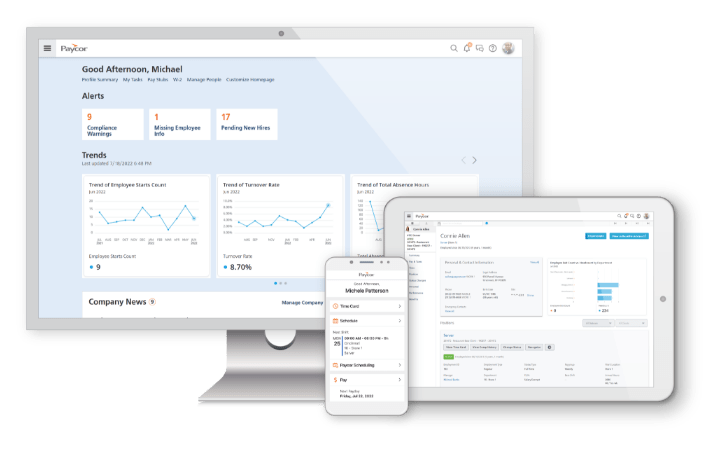These days, running your business without HR software is like embarking on a cross-country road trip without GPS. Of course, you could always use an atlas or take the scenic route without one. But let’s face it: We’re all strapped for time. So, getting to your destination (or business goals) faster is easier with some help from technology.
Fortunately, HR software has become indispensable for HR business leaders to navigate the complexities of HR. The rapid speed of business has every department constantly seeking ways to streamline operations, optimize efficiency, and enhance employee experiences. And that’s precisely where HR software comes into play, to guide you through the HR landscape with ease and peace of mind.
Small businesses use HR software
(Capterra)
Businesses plan on increasing spend on HR technology
(PWC)
Businesses use HR technology to find, attract, and retain talent
(PWC)
Considering these numbers, chances are you may have some level of technology assisting you; however, if you’re just getting started or haven’t recently reviewed all of the new options available to HR leaders, this article is for you. Discover how HR software has evolved to help you attract and retain top talent, deliver insights for well-informed decisions, and be more strategic with your time.
HR Software Terms You Should Know
HRMS, or Human Resource Management Systems, serve as a central hub for various HR functions, including employee data, payroll, recruitment, benefits, training, talent management, and more.
HRIS, or Human Resources Information Systems streamline and manage HR processes, employee information, and policies, enabling efficient interactions and freeing HR professionals for more strategic work.
HCM or Human Capital Management software is often a cloud-based suite of HR applications that help enhance the employee experience. HCM systems, like Paycor, enable leaders to develop strategic decisions around onboarding, professional development, and performance management.
The Benefits of HR Software Services
Although manual HR processes might seem like the most cost-effective method of operation, they can often result in roadblocks and lost time due to errors and cause major compliance mishaps.
Manual HR Mishaps
- Too much time on tasks
- Incorrect entries
- Disjointed systems
- Inability to aggregate and analyze data
- Manual calculations & reliance on memory
In today’s fast-paced and data-driven business environment, the benefits of HR software services are undeniable.
Few organizations are fortunate enough to be fully staffed with talent in all of the 5 main HR roles, which is teams depend on their leaders to choose the most efficient route to success.
Here are 6 benefits of using HR software.
1. Increased Efficiency and Time Savings
HR software automates repetitive and time-consuming tasks, such as data entry, payroll processing, and benefits administration. Time savings empower HR professionals to focus on strategic initiatives that propel businesses forward.
2. Improved Accuracy and Data Integrity
Manual processes are prone to human errors, which can have serious consequences. HR software provides built-in validations and checks, reducing the risk of mistakes and helping to ensure data accuracy. The result: reliable reporting, decision-making, and compliance with regulatory requirements.
3. Enhanced Compliance and Reduced Risks
HR software services often include compliance guardrails that help you stay ahead of changing employment laws and regulations. This helps HR teams avoid penalties and mitigate legal risks.
4. Centralized Data Management
HR software provides a centralized repository for employee data, making it easily accessible, organized, and secure. This eliminates the need for multiple spreadsheets, physical files, or disparate systems, enabling efficient data retrieval, analysis, and reporting.
5. Enhanced Employee Experience
HR software often includes self-service features that empower employees to access and update their information, request time off, and use other HR resources independently. This improves employee satisfaction and engagement by providing quick and convenient access to HR services and removes the administrative burden from HR teams.
6. Scalability and Adaptability
As organizations grow, manual processes can become overwhelming and inefficient. HR software can scale with the organization’s needs, accommodating changes in workforce size, structure, and complexity. It also allows for easy customization and integration with other systems. This flexibility helps businesses scale up when they’re ready.

Discover the Benefits of Paycor’s HR Technology
How Can HR Software Specifically Help HR Leaders?

Employee Database Management
When HR leaders can embrace the power of automation to optimize processes, they can use the time saved to be more strategic.
Here are a few examples:
Example #1:
Forget file cabinets and paper records, HR software provides a centralized database to store and manage employee information, including personal details, I–9 information, employment history, performance data, and more. This feature allows for easy access, alerts when information is out of date, and quick retrieval of employee data. Imagine how much better onboarding could be if new employees completed paperwork prior to day one. Spend the time you save getting new team members integrated into company culture and set up for success in their new roles.
Pro Tip
Just in case you are still doing it the old-fashioned way, there are at least three categories of information that your organization should retain through the duration of your employees’ career (and afterward). This includes personnel files, medical/benefits files, and payroll files. There are also miscellaneous files that should be kept related to FMLA, EEO claims, COBRA, and more.
Here’s a helpful checklist for you: How to Maintain Employee Records and a guide on How Long to Keep Employee Records
Example #2:
HR software often includes tools for tracking employee time and attendance. This can involve features like clock-in/out functionalities via a mobile device, timesheet management, and leave tracking. Save your brainpower and eliminate manual calculations and time theft with automated timekeeping. Moving away from manual timekeeping can open up a new world of possibilities, including finding efficiencies from labor costs, analyzing attendance trends, and optimizing scheduling.
Pro Tip
If you’re in the market for an employee time clock, here are 3 things you should check for before you spend a dime: 3 Things to Consider When Buying an Employee Time Clock
Example #3:
Benefits Administration software helps manage employee benefits programs, including health insurance, retirement plans, and other perks. Automating open enrollment tasks will free you up to re-evaluate benefits to better fit your employees’ needs.
Pro Tip
If you need help building your benefits program, we’ve got you covered. Discover the four steps involved in designing a great employee benefit plan for all kinds of employees. How to Craft Employee Benefits Plans for a Multi-Generational Workforce
HR Software Innovation
Consider this: road navigational systems used to be bulky stand-alone devices we’d power up on every trip; now, many cars have these systems built in. Much like other technology, HR software has undergone remarkable innovation over time, particularly in the areas of recruiting, people analytics, and learning management with the integration of artificial intelligence (AI) leading the way.
AI-powered recruiting software now streamlines the hiring process by automating repetitive tasks and identifying top talent through advanced candidate matching algorithms.
Similarly, AI-driven analysis tools have revolutionized how organizations review information to learn if employees are in danger of leaving, determine fair and competitive pay structures, and distil vast amounts of data, market trends, and employee performance metrics to provide accurate insights and recommendations.
Paycor is on a mission to integrate cutting edge technology to keep our customers prepared for the future of HR.
These advancements in HR software have not only increased efficiency and accuracy but have also enabled HR professionals to make data-driven decisions that align with organizational goals and drive better outcomes.
How to Choose HR Software
When searching for HR software, it’s critical to avoid off-the-shelf solutions that don’t cater to your organization’s unique needs. You wouldn’t choose just any car for your road trip. A reliable payroll system should adapt to your requirements and be accompanied by comprehensive support throughout the entire process, from pre-purchase discussions to implementation and beyond, offering clear communication, thorough training, and prompt assistance. To kickstart your search, consider the following key factors:

Seamless Implementation Process: Opt for a provider with a proven implementation track record and seek references from businesses similar to yours to assess their success.
User-Friendly Experience: Look for an HR solution that boasts an intuitive interface, easy navigation, and accessibility across multiple devices.


Integration Capabilities: Prioritize a provider that offers seamless integration between payroll, HR, and time systems, minimizing duplicate data entry across various platforms.
Employee Self-Service Features: Consider the needs of your workforce and choose an HR solution that empowers employees to access crucial information independently, such as pay stubs and schedules.


Tax-Filing Services: Select a provider that offers streamlined tax filing and reporting services, helping you stay compliant with federal, state, and local tax regulations to mitigate the risk of fines and penalties.
By taking these factors into account, you can identify an ideal HR software solution that aligns with your business needs, provides an excellent user experience, helps ensure compliance, and offers ongoing support.
Need more guidance?
How Paycor Helps
Paycor HR software is built for HR leaders.
Paycor has more than 30 years of experience and more than 30,000 customers who trust us to pay their employees. With Paycor, HR leaders benefit from offloading administrative tasks, while employees benefit from a seamless experience.

Employee Self-Service
Nearly 87% of organizations use employee self-service (ESS). Employees can change their contact and banking information, access their payroll, schedules, benefits enrollment and more, without HR being involved.

Compliance
The system is continually updated, so you’re always in step with local, state, and federal laws. The Paycor compliance dashboard also alerts you to missing information and potential problems. Paycor also provides tax recommendations for each employee based on where the person lives and works.

HR Support
In addition to up-to-date resources and HR software tailored to fit your needs, Paycor also provides an HR Support Center where you can find informative articles, tools, forms, and checklists to help you navigate through HR challenges at every turn.

















